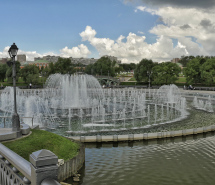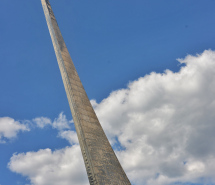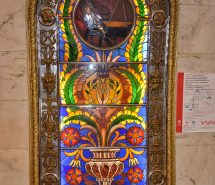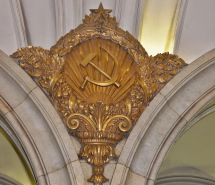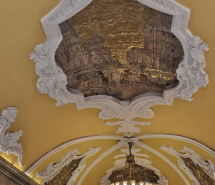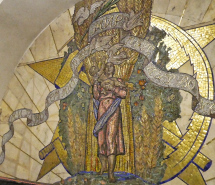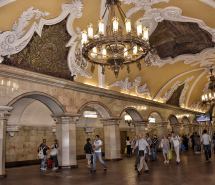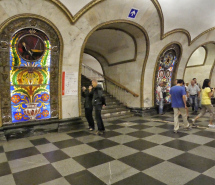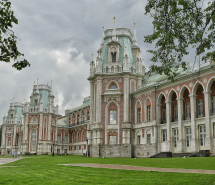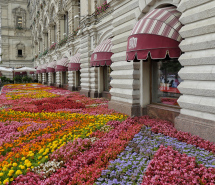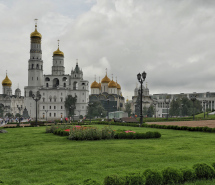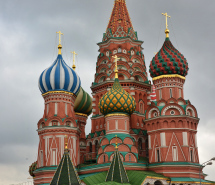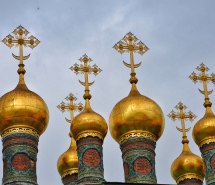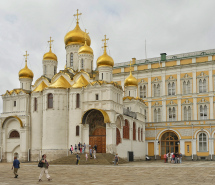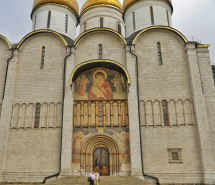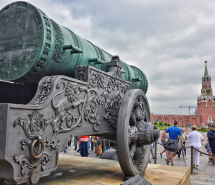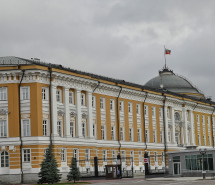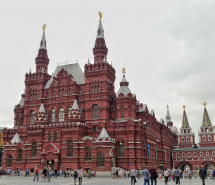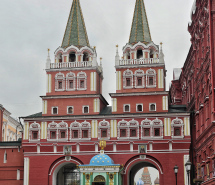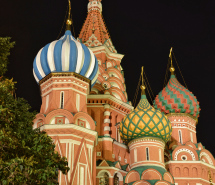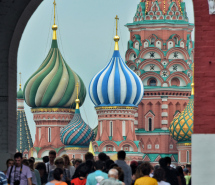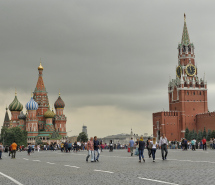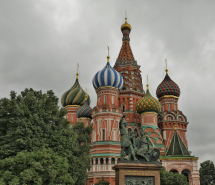Moscow is a very cosmopolitan city, the women are beautifully dressed and sneakers are not worn unless a is performing athletics, or a tourist is visiting. What I realized is that tourists are performing athletics. In the space of beautiful, interesting and diverse 3 days, David and Karen walked 25 miles!
We decided to use guides in Moscow. Three delightful ladies shared their day with us, showed us a city they loved. Kremlin, means walled fortress and there Kremlins in many towns, THE Kremlin means HUUUUGE fortress in Moscow. (Like THE Donald there is only one!). It is shaped like a triangle with red brick, square towers on each corner, also at the entrance. Notice the double headed eagle on top of the tower, it is the symbol of the Republic. Construction of the existing red brick walls lasted from 1480 to 1495. This structure was being built the same year Christopher Columbus discovered the New World! Our lovely guide Angelina shared the Kremlin with us.
The Kremlin has both a tourist and a governmental purpose. The state office is the big yellow picture. That’s where Putin works. The Armory, where cannon from various wars are displayed, we are standing next to cannons used against Napoleon. The “N” is engraved on the metal and the cannons are named for ladies, much like boats. (No Karen, I looked, it must not have been popular in 1812). There was a Czar’s cannon, it is the largest cannon in the world, and luckily has never be fired in battle.
Uniquely, Russia builds churches to commemorate significant events, wars won, rulers death, etc. We saw three churches, (classified as museums) the Annunciation Cathedral; it served as a personal church of Russian Czars. Czars used to spend some time their, every morning to pray for deliverance from countless perils. The Cathedral of Twelve Apostles is connected to the Patriarch’s Palace and was considered his private church. Patriarch is the title of the head of Russian Orthodox Church. (We didn’t see that one but it is all those crosses, 12 apostles). The Church of St Michael; was used as the cemetery for Czars. And the most important of all and also the biggest church in the Kremlin – the Assumption Cathedral. Since the end of the 15th century it had been the place for every coronation of every single Czar until the last one – Nicholas II. Inside these churches/museums, every square centimeter of walls’ surface is covered with murals, left and right walls picture biblical plots connected to the name of the church.
The Armory houses all the state treasures from Russian history. Its name comes from the actual arms workshop of the Kremlin. Besides arms, it also hosts the collection of royal regalia, carriages, dresses, tableware and ambassadorial gifts. The Armory also contains the Diamond Fund Museum, which is the state jewels worn by the Czars and their family during their reign. Huge diamond collection which includes: raw diamonds exceeding 50 carats; cut diamonds exceeding 20 carats; cut diamonds of exceptional quality exceeding 6 carats; raw emeralds, rubies, sapphires exceeding 30 carats or 20 carats cut unique nuggets, amber, pearl and jewelry, including diamond laid crowns, baubles with 50 carat emeralds, broaches, and rings. It is the third largest collection of precious stones in one place. (First is the Royal Family of Britain, second is the Shah of Iran). Preservation, sales and looting of imperial treasures after the Russian Revolution of 1917 is a matter of controversy and speculation. The Imperial collection was moved from Saint Petersburg to Moscow during World War I; the Soviet Diamond Fund was officially established in 1922 (official site). The treasure was first exhibited to the public in November 1967. Originally a short-term show, in 1968 it became a permanent exhibition. It was impressive.
You move from the Kremlin into Red Square. The big open brick patio in the pictures is red square. It is called “red” because that is the Russian word for beautiful. One side of Red Square is the Kremlin Wall, the second is a large red brick building that houses the Russian Natural History Museum, third was the GUM state department store and the fourth side is ST Basils Church with its onion dome roofline. St Basil, commissioned by Ivan the Terrible, was erected to memorialize the military conquest over Kazan The people of Kazan were colorful, so the architect decided to add the colorful domes to the memorial. It is now of course, a wonder of the world. And, of course, one of the most photographed sites in Moscow.
Also in Red Square, which we did not take time to visit, is Lenin’s Mausoleum (Russian: Мавзоле́й Ле́нина, tr. Mavzoléy Lénina; IPA: [məvzɐˈlʲej ˈlʲenʲɪnə]), also known as Lenin’s Tomb, situated in Red Square in the center of Moscow, is a mausoleum that currently serves as the resting place of Vladimir Lenin. His preserved body has been on public display there since shortly after his death in 1924, with rare exceptions in wartime.
The Moscow subways are public art. On the circle line, 5 stations have murals or stained glass, paintings, etc. People pass through the station rushing like people in all big cities to their destination. Oh to look up, and see the beauty. On a personal note, there was no litter, or tagging, anywhere in the city. It was a beautiful city filled with many parks and fountains, abundant green space and efficient public transport.
We traveled to the suburbs to see the summer palaces of the Czars. One was a log lodge, built by Czar Alexis I, it contains a mere 400 rooms, and the large gothic one belonged to Catherine the Great, however, she died before it was finished so it remains unfinished to this day. This started a discussion with our lovely guide Anna, about Downton Abbey, and the lives of the aristocrats in Britain. That’s one for PBS and one more addicted viewer.
Our lovely guide Victoria, took us to the Cosmonaut museum. The original Sputnik was there, and a mock up of the International Space Station. There was a live feed showing the current position of the ISS and satellites in space. Rockets, and satellites, the evolution of space suits and even the story of the first creatures in space — two small, Russian dogs and other small animals and monkey, all stuffed for your viewing and praise.
We ate amazingly well, we kept ourselves busy in the evening with the Youth Theatre ballet production of Sleeping Beauty. (The Bolshoi was on summer break.) Moscow Circus provided another nights entertainment, and is another Moscow staple. I went on a shopping excursion with Anna, who translated while we shopped for a piece of Russian red gold jewelry. Karen’s jewelry box is filled with one of a kind bling with memories of places and faces attached. It is lovely to add one more.
It’s been very educational summer: in the United States we visited sites of the American Revolutionary War; The Civil War; and now in Europe: World War II; and The Cold War.
Author Miriam Beard said, “Travel is more than the seeing of sights; it is a change that goes on, deep and permanent, in the ideas of living.” Our view of Moscow has certainly changed, thru seeing it with own own eyes, the kindness and friendliness of our guides, or experiencing another piece of history first hand.
After four nights in Moscow we departed via airplane to Copenhagen, where we will embark on a 12 day cruise of the Baltic states.



